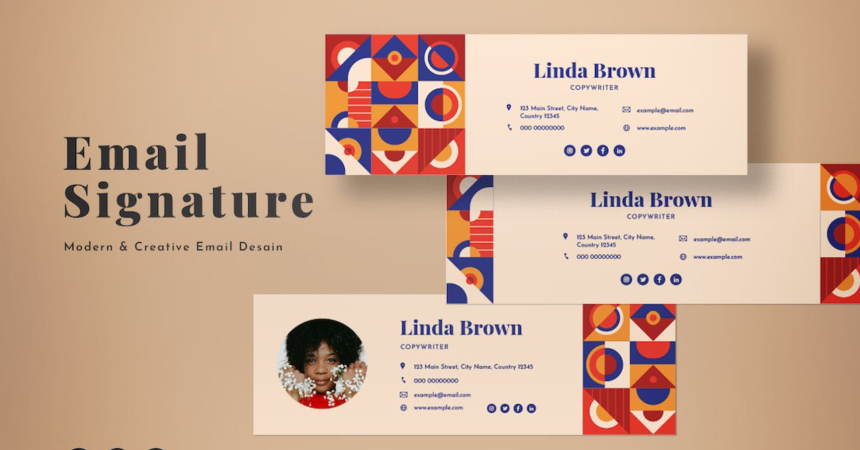Email signatures are becoming an increasingly valuable aspect of professional communication. They provide a way to convey contact information, branding, and other pertinent details to recipients of an email without wasting a lot of time on additional messages with questions and answers.
Moreover, with the rise of digital communication, email signatures have become an integral part of how individuals and businesses present themselves because it’s signature that may convey the visual identity of your brand or present your own photo and style to the client or partner.
One of the most convenient ways to create such a signature is using special generators. They can have features conditions and abilities, but in general, those are the most common and probably the simplest means. There you can find personal email signature templates, and a range of fonts, colors, and instruments that will help you in the process. In general, an email signature layout is a helpful tool that saves you much time.
In fact, with a few clicks, everything would be ready. But the things that matter in this case are the choices you make. Your signature must achieve a balance between creativity and professionalism, so it’s essential to understand basic rules of composition and design. As we have said, we are here to help you with this issue, offering some recommendations.
It is pretty obvious that a well-organized email signature layout can make a lasting impression and convey a sense of professionalism. Many individuals and businesses choose to use personal email signature templates to ensure consistency and branding across all communication.
Personal email signature templates can be customized to include various elements, such as company logos, social media links, and contact information. Additionally, email signature layouts can be tailored to the specific needs of an individual or organization.
For example, a business may choose to include a call-to-action or a promotional message in its email signature layout to drive engagement and increase brand awareness. But we will discuss all the elements which may suit your signature in more detail a bit later.
When creating an email signature, it’s important to keep in mind that it should be concise and visually appealing. A cluttered or poorly designed result can detract from the overall message and cause recipients to overlook important details. But being brief and creative at the same time may grant individuals and businesses that their communication is professional, effective, and visually engaging.
So, we have our first rule: be precise. Your signature must be a visit card, the handshake, the final smile, but not a novel. Nobody likes things that take much of their time, and the purpose of an email signature is to create a quick and memorable list of contact information, links, additional details, etc.
As the age-old saying goes, “the devil is in the details,” and this couldn’t be truer when it comes to crafting a compelling email signature. Think of your signature as the cherry on top of a sundae, the final touch that ties everything together and leaves a lasting impression. So, add only that information which you find valuable.
First of all, your email signature should contain your name, the name of the brand or organization you represent (if you do, of course), it may contain your photo so that the partner or client will get to know you closer, and it should describe the ways of how a person may reach out to you.
Still, don’t be afraid to inject some personality into your signature. Sure, your name and contact information are important, but why not spice things up with a witty quote or a fun fact about yourself? This can help make you more memorable and create a connection with the person on the other end of the email. After all, presenting your creativity and personal style, your brand identity is also a goal of your email signature.
In other words, dare to experiment, but try to stay professional. Don’t overuse colors and fonts (two-three would be enough), add only those images which have good quality, and don’t put unnecessary links if you don’t tend to use those resources which they represent. Avoid using slang or inappropriate language, and make sure your signature is appropriate for your industry and audience.
Surely, make use of icons and graphics in your signature. Instead of just listing your social media handles, include clickable icons that link to your profiles. This not only makes your signature more visually appealing but also makes it easier for people to connect with you on various platforms.
As we have already noted, consider adding a banner or logo to your signature. This is especially useful if you’re sending emails on behalf of a company or organization. A branded banner or logo can help establish credibility and make your signature look more professional.
Finally, make sure your signature is mobile-friendly. With more and more people checking their emails on their phones, you want to ensure that your signature is easy to read and navigate on a smaller screen. Keep it simple and avoid using images that may not load properly on mobile devices. In other words, keep up with your times. It’s the only way to stay modern.
Make sure to review and update your signature regularly to ensure that all of your contact information is accurate and up-to-date. This includes your phone number, email address, and social media links. If they will turn out to be irrelevant, adding them would only harm your image.
Your email signature is also a great opportunity to encourage your recipients to take action. Whether it’s to visit your website, schedule a call, or follow you on social media, include a clear call-to-action that encourages people to engage with you further.
Consistency is key when it comes to branding, so make sure your signature follows a consistent format across all of your email accounts. This includes using the same font, color scheme, and overall design.
Depending on your industry or job, it may be necessary to include a disclaimer in your email signature. This can be a legal disclaimer, a confidentiality statement, or an anti-spam statement. Still, the situation usually does not require you to add such.
If you have a specific area of expertise or certification that sets you apart, consider including it in your signature. This can help establish credibility and showcase your unique skills and qualifications.
And if you have received positive feedback or testimonials from clients or colleagues, consider including a quote or snippet in your signature. This helps build trust and demonstrate your value to potential clients or partners.
We believe that by following these tips and continually refining your signature, you can create a compelling and effective email signature that helps you stand out and make a lasting impression on your recipients.
So, to sum it all up, imagine what you would like to say in farewell. What exactly you would like to be remembered for by a person? Everything that pops into your head is worth adding to the email signature. Because everything we have described is only a recommendation – in fact, you are free to make your own decisions. You can sacrifice certain elements that we have discussed in favor of those that seem more important to you. But we really recommend remembering these main aspects: brevity, creativity, and professionalism. Experience shows that these frameworks are needed, they seem vital.














